I was born in Austria. English is my second language. Yes, I write a lot, but I do it because I want to share my expertise, not because I believe that I am a great writer. Yet today I set out to blur the lines of copy writing, branding, enthusiasm, content strategy, your target audience and content overload. Launching your brand puts an emphasis on the About section of your web site, no doubt about it. Even if you have a video and to-the-point messaging on the Landing Page(s), the About page will be sought-after. It needs to explain the following in a swift manner:
That’s a lot to convey on a single page and therein lies the problem for an enthusiastic entrepreneur who writes this important piece of content in a stream of consciousness (it is after all the subject you know best), then quickly proofs it, and by the push of a button publishes it. Rarely do they look back. Yet another item checked off the busy to-do list. Then the journey of marketing and metrics hits in and the About page, long forgotten, is like ‘a ghost employee’ in a well functioning company; it lives on yet it should have been let go and replaced a long time ago.
I know this feeling well. I see it on a nearly daily basis with our new clients, but I also fell victim to it myself. Here are my top 4 tips on how to go about deriving your About copy:
It has to be right. You can’t just block off an hour on your busy calendar. It has to be more like that moment when you drive to the beach to just sit and breathe and think big thoughts. Make the time for that moment and don’t put a time limit on it. For myself that moment arrived during a 12 hour flight after I have answered ‘all’ E-Mails and there was no WI-FI for new ones to trickle in. I watched the Steve Jobs movie (Inspiration 1), had a glass of wine (Inspiration 2), the cabin lights went out so everyone could sleep (I was in Coach – Inspiration 3), and I knew if I started writing now that I had hours and hours to fine tune and contemplate. And so I did – the time and place were right. Best of all, even if I wanted to, I could not just push it live as I did not have WI-FI, so it forced me to sleep over it and make even more tiny edits when ‘back on the ground.’ It took me 3 hours to write.
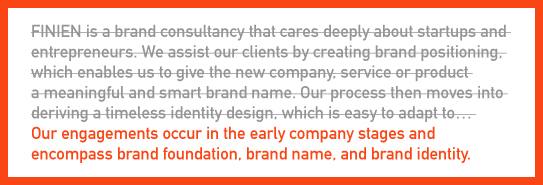
Edit, edit, pause, then edit some more.
Words should not come easy (Ask F.R. David, he knew). If they do, consider it a brainstorm exercise, then work on a synopsis of that copy. Don’t cut paragraphs, don’t review sentences, dive deeper and focus on it word-by-word. In the end your About copy should be thought of as a lineup of tag lines, because in a tag line every word counts, has meaning, adds to your brand story. Think of each word as a strategic component to the whole.
Once you feel you phrased it in just the right way, make sure it will resonate with them. Sounds logical, hence easy, but it is one tough role play: Write in an emotional and enthusiastic manner that conveys your brand’s soul, but then read it from the perspective of your target audience. It helps when you created target personas, that way you can read pretending you are that specific person. If time allows, run it by your target audience and conduct a mini focus group, or even A/B testing of different About pages, to see what sticks.
Make it as simple as possible. Make it as short as possible. If you need to, add links to further content below your CTA (Call To Action). No one reads a long About section. No one. Rather go through steps 1-3 and then edit it down again and have something your audience will actually be compelled to read, because it is short and approachable. This is about getting them excited to keep going further, to click deeper, it is not the page that needs to convey everything, but ensure it has the 5 components listed above embodied.
In a study of user tests it was discovered that users with higher literacy levels also fared better on web sites written for a lower level literacy audience. So keep it brief and keep it simple. I guess I should go back and edit this post, but I don’t feel too bad keeping it this length as someone just released the book ‘Brief: Make a Bigger Impact by Saying Less;’ it spans 256 pages.
Working with startups on developing new brands on a daily basis, we had a pretty good idea about our clients’ key struggles, but we reached out to entrepreneurs purchasing our book and asked them what they perceived their biggest hurdles to be. Here are their top 3 pain points:
Are you surprised?
I was.
Not about the fact that positioning is the most important component of a brand launch. After all, it is the one that takes the most out of entrepreneurs as it requires a refined mixture of many diverse skills – creativity, industry insight, foresight, process and honesty (among others), and it is something that is very hard to create in a silo. What did surprise me was that entrepreneurs see the importance of positioning so clearly and that they are humble enough to acknowledge the DIY approach might not suffice when it comes to this aspect of their brand launch.
Positioning is at the core of brand development, it forces you to answer the question Why, long after the questions What and How have been settled in your mind and you have decided that there was a need and you had the means to start that new business, or create that new product. The direction of the business has been set, but the direction for the brand has yet to be created (and synced). I believe most entrepreneurs start diving into positioning (and the overall creation of the Brand Platform), too far down the line, which adds to the fact that 46% of our respondents see it as their core branding issue.
What is, or was, your biggest pain point with your startup? Do you agree with our readers’ responses?
If you are struggling with positioning, we created a white paper on the subject (free download).
CATEGORIES: Blog Your Brand Launch: Brand Strategy
When I was 8 years old I started ‘a publishing house’. I named it Buttersemmelweich Verlag. A real memorable name, right? It translates to ButterBreadSoft Publishing Co. It only published a single magazine, but over the course of several years. It was called SNOOPY. Go here for a stunning visual I dug out from the family archives just for you. Please note the Nike logos on Snoopy’s shoes, a sign of innocence lost and a hint of my future in branding. Perhaps the Charles M. Schulz Museum (which I can highly recommend a visit to) will sue me for the 6 issues I sold – yes, the young entrepreneur that I was I actually asked my family members to pay for my work. Just like a retainer, each issue I drew and wrote was copied 6 times (by my mum) and always sold out (to my mum Etc). As I grew a year older the name of the magazine was changed to JoeCool, an obvious transition, and I brought on ‘a partner’ as one ought to do, especially since I could not use the typewriter yet. My fascination with magazines grew over the years. As a young communication designer I felt the need to be on the forefront of pop culture, to be informed about as many topics as I possibly could in a swift and constant manner, while being surrounded by the freshest fonts and layouts. Since the internet has not quite been as giving back then as it is today, buying as many magazine subscriptions as possible was my goal. I have since adjusted my subscriptions, but have not kicked the habit. Needless to say, I have seen (and over the years also professionally designed) plenty of magazines.
As I descended into the current issue of Bloomberg Businessweek a couple of evenings ago, I was shocked before I could even flip to Page 2. The cover was bad. It was so bad that it was actually appalling to me. Judge for yourself:
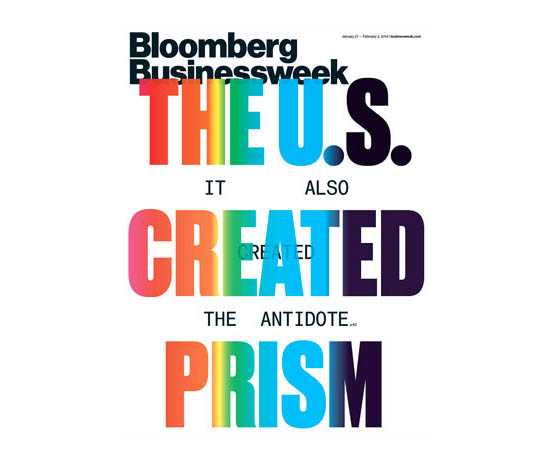 I was shocked, not a bit intrigued, only shocked, and a little sad as Bloomberg Businessweek has been pushing its design steadily after its acquisition in 2009. Conceptual, socially challenging and often shocking cover designs were part of their re-branding. But this cover is just shockingly bad.
I was shocked, not a bit intrigued, only shocked, and a little sad as Bloomberg Businessweek has been pushing its design steadily after its acquisition in 2009. Conceptual, socially challenging and often shocking cover designs were part of their re-branding. But this cover is just shockingly bad.
How did it happen and why would you care?
Bloomberg Businessweek shares the story on how the covers were conceived in each issue, on Page 2, right next to the index, a prime location for any magazine. So here it goes:
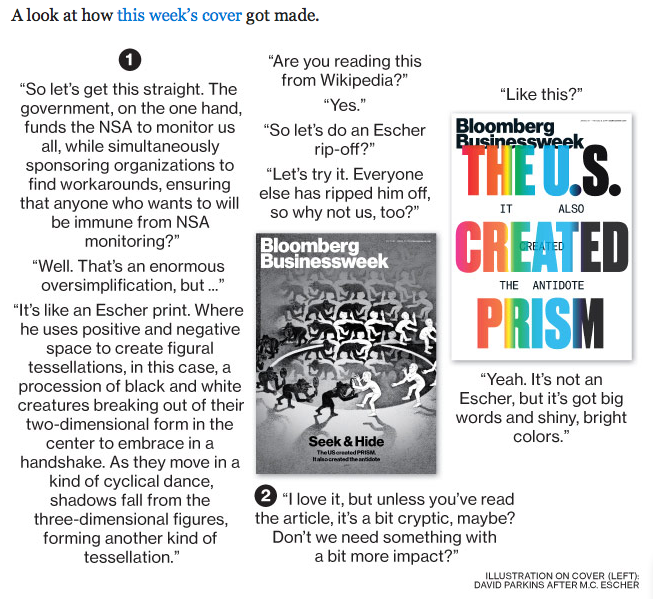
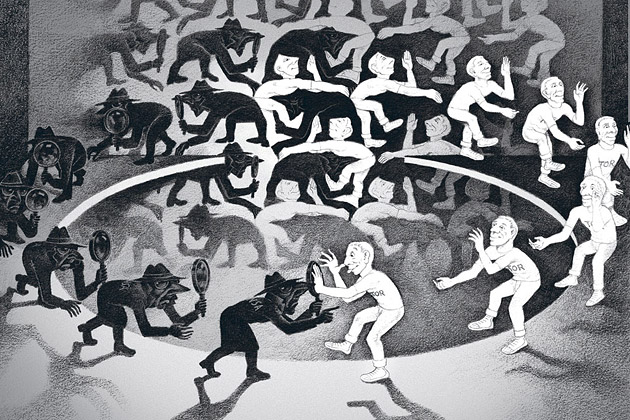
Image Source: Bloomberg Businessweek
Yes, indeed they talk about ripping off MC Escher – and may I add that the original design (above) also has a touch of Spy vs Spy ‘borrowing.’ Alright, I registered that as a bizarre strategy statement, but going from a solid conceptual and surely intriguing (yet copied) design to a horrendous – ‘at least it’s got big colorful letters’ – solution makes it obvious that the chosen design option only made it to the cover in a rush to meet print-deadlines (imagine how long the Escher illustration must have taken to create?).
As the reader, a consumer, the target audience, do you see the problem? Sharing both designs and the decision criteria is a very bad brand decision. If the cover design is genius, Bloomberg Businessweek’s story on how it was made is only killing the magic. No room left for imagination. Even worse, we can see how bad the other cover design option was, making the amazing design option that much less great as we want to feel designs go from good to better to great. If the design is really bad (as it is in the current issue) and the option that did not make it would have been significantly better (as was the case in the current issue), the reader is upset and disappointed by Bloomberg Businessweek’s choice. This is obviously not good for a brand and I see this as an open letter to Bloomberg Businessweek to change its strategy and to use this Page 2 real estate for something that works for, instead of against, its brand.
As an entrepreneur, never share your design options with your audience at large. It’s tempting as they are the ones that will need to buy (into) it. If you really don’t trust your brand or design consultants, have a small and narrow focus group, if you must, but do not share design options with your entire audience. Not during, and definitely not once they have been made. Most everyone who did not go through design college tends to screw this up big time. Look at Marissa Mayer’s big fail when introducing the public to Yahoo!’s logo re-design last year. Everyone got excited, everyone had their favorites, and then…a universally disappointing final choice.
The habit of sharing creative options is one of over sharing, or TMI as one would text. Don’t fall into this invitingly open trap as your audience’s TMI feeling would very quickly morph into an OMG and a WTF (Excuse my language) expression on your end. Spare yourself, and your brand that pain.
I am not sure about you, but I can not stand leaf blowers. The concept does not work for me in any way.
Now if you live outside the US, or in a region that has sane laws restricting or prohibiting the use of such evil devices, you may not know what I am referring to. The concept is simple: Leaf blowers use high pressure air, like a fan or hairdryer on steroids, to move leaves from one area to another, most often this means your gardeners blow them to your neighbors, or onto the street. Problem solved? Not quite. Either your neighbor hates you now (even a bit more), or the wind blows them back to you, eventually. Solution? Have the leaf blowers come by more often.
Now that I filled you in, let’s do this again:
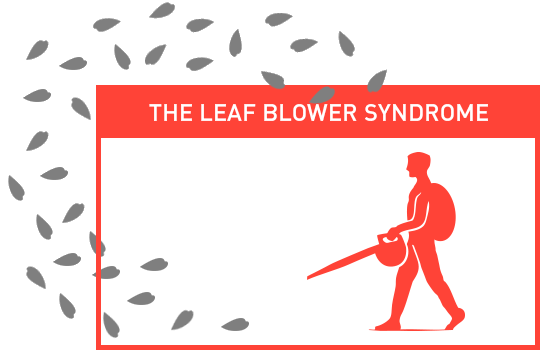
Leaf blowers postpone an issue, while displeasing everyone who gets in touch with them. It stinks up the neighborhood, is annoyingly noisy and pushes a problem from one place to another. Bingo! Out of sight – out of mind. Now that was quick and cheap. Consider those massive amounts of leaves handled.
On my way to our office last week, my thoughts deeply entrenched in the world of branding (as you’d expect), leaf blowers pushed their leaves smack onto a busy street during rush hour traffic. As I passed them I saw those leaves go absolutely everywhere; mostly right back to where they came from. It made me think of all these startups saving money bootstrapping (Hint: ’99 Designs Dot Com’) – now read these two words carefully – their identity by crowd sourcing it to strangers to create cool designs. They will not arrive at a solution easily, so they get more leaf blowers to work faster and more often creating vast amounts of different logo designs, spending hours over hours discussing the designs they receive in their Inbox until they need to just pick the one they ‘like’ best.
A couple months later early brand adopters gather and success hits. The wind has changed, the leaves are coming back. This is the point in which they realize that the logo is not their real identity. It does not connect. It is missing meaning. It does not have nor create a story. They need to re-brand, even though they just spent all that time and energy, and by now even a sizable expense. And this time it is going to be much more costly then had they done it right from the get-go. They have to re-educate their customers, hire a specialist whom they pay professional fees like they do with their other consultants. They need to re-create all touch points from the web site via all the collateral to perhaps even the signage. It stinks.
If you ask successful startups what they would have done differently in retrospect, many say they wish they had not cut costs on their initial branding or web site efforts. The wind changes, the leaves come back, but at that point the neighbors already like you that much less and making up is hard to do, a much lengthier process that involves other ‘leaf-behinds’ (sorry, I just had to!).
I recall my parents picking up leaves in batches in our garden and carrying them to the compost to get rid of them. Now that makes a whole lot of sense. It definitely was a time investment, but only a one-time investment. It even had a romantic part to it. It showed they cared and that the seasons were changing.
Pick up the pieces, make sense of them, do it with love, and it will show. Just remember, it’s your startups identity.
For a consultancy that has a clear focus on brand creation, you might have wondered at some point why we did not create a stunning icon or a splashy in-your-face logo for our own company. Are we not following our own rules, are we lazy, or is there a different strategy at play? Ask no more, the myths will be busted today.
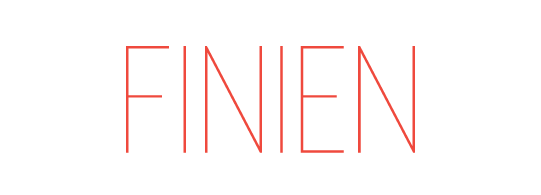 I decided early on, even with my former company, Geyrhalter & Co, that designing a logo in its truest form for a business that is in the business of designing logos would not be the right path – it could only back fire. It might be too ornamental, too colorful, too round, too square, too bold, too…anything really that does not fit our prospects’ bill of decorative wishes and likes. We do not want to attract clients based on a graphic style, nor would we want to scare them away using a specific style. We are in the business of creating your brand, ours should remain in the background.
I decided early on, even with my former company, Geyrhalter & Co, that designing a logo in its truest form for a business that is in the business of designing logos would not be the right path – it could only back fire. It might be too ornamental, too colorful, too round, too square, too bold, too…anything really that does not fit our prospects’ bill of decorative wishes and likes. We do not want to attract clients based on a graphic style, nor would we want to scare them away using a specific style. We are in the business of creating your brand, ours should remain in the background.
In other words, it’s a bit like the design of a logo for an exclusive car seller that focuses on the newest and most luxurious models. He decides to have a visual representation of a Tesla turn into the logo. It represents a true cutting edge car while surely representing luxury. To him. And only today. A dumbed down comparison, I know, but you get the point. A brand identity design (through its 3 components) should describe what you are in business for, it should show your brand’s personality, touch on differentiators and your brand’s core values, but it does not need to, and most of the time should not show the actual product.
Our brand design needed to lead, it had to be professional and sophisticated, but simple, clean, and most important non-invasive. Below screenshot of my former brand agency’s Facebook page header shows how our simple logotype was floating above the work we did for our clients, making a clear statement of who was responsible for the brand visuals, yet distancing ourselves from all the colors and graphic shapes of our work.
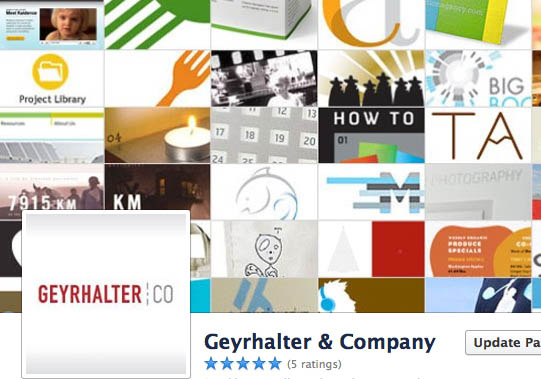
When working on our brand identity design we took many paths before arriving at our current logo, which portrays innovation and disruption through sheer use of a bright and unusual poppy color, while the simple custom typography signifies openness and professionalism. When we launched FINIEN, it looked like an established company from day one, yet a disruptor with an open mind. It had fulfilled its purpose, matching strategic goals with final design. It has treated us well, even if it does not have a cool icon or splashy design, actually, because it does not have it.
CATEGORIES: Your Brand Launch: Identity
When we think of brand we first think of logo (even though we know a brand is much more than its logo). The logo is the key point of visual interaction with a brand, hence we are likely to recall it every time we think (or talk) of – or write about – a brand.
During the brand identity (‘logo‘) design process entrepreneurs often forget that there are 2 other elements that help tell the company or product’s story. They interact and bring value to the brand identity as a whole. Do not repeat the same message, but instead ensure to leverage these 3 core components to create a stronger, deeper brand message:
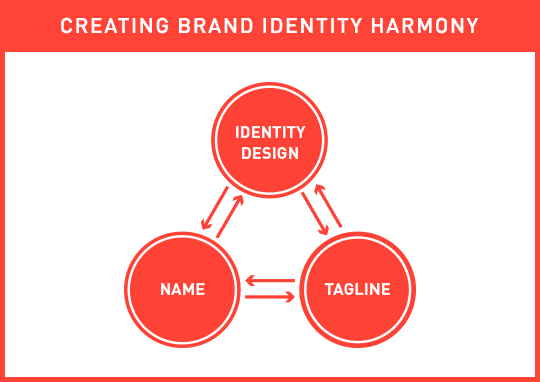
The 3 core brand identity components need to complement each other, each adding something unique to the whole story, and together forming a cohesive and strong initial brand message.
If your name describes your business, do not focus on showing the same message in your logo; instead use your logo to talk about other key elements that describe and differentiate your business. If you are in the cloud storage business and your name includes the two words cloud and storage (A bad company name, yet good example: Cloud Storage Ninjas), have your logo visualize security and stability, if those are key components of your brand’s message. Contrary, if your name is nondescript, either fabricated or an acronym, ensure that the associated brand identity design visualizes what you are in business for (EG: “Cloud Storage“).
Often forgotten during the brand identity design process (and beyond) is…the tagline. There are many factors to blame for the slowly occurring extinction of the tagline (mainly of digital nature, as tag lines are hard to squeeze into apps and templated web sites), but the power of a great tagline is still immense (Just do it, I say!). The tagline should be alive and kicking even though its placement has changed (from the traditional place below the brand identity design). It can now be used as the first header users see on a brand’s web site, the descriptor below the company name in an email signature, in place of yet another step-and-repeat icon pattern on a back of a business card, or in the often underestimated – yet early – brand touch point, the lobby of a business. The tag line is a powerful tool, that, together with the name and brand identity design, tells a stronger, deeper and more actionable initial brand story. It is a leading actor and you can write the script.
Keep the bigger picture in mind when embarking on your identity design project and use your Brand Platform to ensure these 3 core elements touch on more than just one or two of your core values and differentiators (while keeping it visually simple).
Next week I will talk about why our identity design looks the way it does. Are we not following our own rules, are we lazy, or is there a different strategy at play? Hint: It’s the latter.
CATEGORIES: Blog Your Brand Launch: Brand Atmosphere Your Brand Launch: Identity Your Brand Launch: Naming

Steven Balaban is the founder and CIO of Mink Capital. He has read over seventy business books in the last six years and has recently launched the site Best Business Books To Read to share his knowledge.
“I am fascinated by the launch of the Samsung Galaxy Gear Smartwatch. I first learned about the watch through a social media campaign that focused on a video that shows characters in TV shows, such as The Jetsons and Star Trek, using futuristic watches. The campaign claims that “The Next Big Thing is Here” and the video definitely gives that impression!
I remember the days when I was backpacking around Europe with my old camera and eight rolls of film. Now, I can travel with a 1.9 megapixel digital camera around my wrist. Am I really that old?”
Samsung Galaxy Gear- A Long Time Coming on Vimeo.
Although launched only about 3 months ago, in the cell phone and gadget market, the Galaxy Note 3 is by now light years away from being a ‘new brand.’ Steven selected a truly innovative product, one I was curious about for a while and one that makes it hard to do our job; discussing the name, identity and digital brand atmosphere. We like to be challenged:
Cell phones fall into the category Fax and Copy machines once fell into. The inaugural product name (The iPhone, The Galaxy) sound sexy and/or inspirational, and at the time the iPhone 5c and the Galaxy Note 3 launch, they turn into fax machine names. More troublesome for Samsung though is the naming strategy behind the truly innovative part, the introduction of its Smartwatch. It has been degraded to ‘Gear’. Verbatim: The Samsung Galaxy Gear. Representing the only such ‘gear’ (there is only the watch), the choice is baffling to myself and confusing to the consumer, when all they want to call it is ‘the watch’.

The name is the first step to defining a brand’s identity, and with a 4-part name the brand identity design is quite a train wreck that is as hard on the eyes as it is on your tongue. You won’t fall in love with the name, nor the logotype, so what to do? Throw in Robin Thicke, add a hashtag (#DesignYourLife) and let’s not bring up ‘Samsung Galaxy Note 3 + Gear’ too often. Nor the Jetsons, Thicke replaced you and Knight Rider as of now.
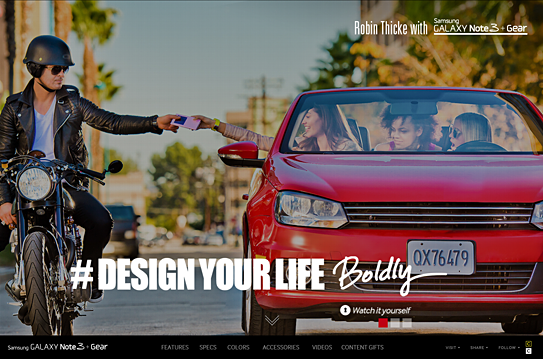
Seems as though the majority of the budget was spent on the highly produced Robin Thicke commercials, hence they occupy the landing page in its entirety. A bold move, one that leaves the user ‘interacting’ with the brand and ‘exploring’ the site, but truthfully, it means that they are lost looking for details on what the SGN3+G (Forgive me for not spelling out the full name) can really do for them. We soon learn that the site itself has been overproduced as well, taking advantage of many bells and whistles of today’s web design yet leaving functionality and plain product info, features and calls to action behind. The web site is the number one informational source for gadgets, being so cumbersome to navigate, it leaves me thinking that the SGN3+G might offer the same clunky experience.
From a brand experience perspective I might leave the ‘gear’ behind and wait for a ‘smartwatch’ after all, as there will be many to chose from shortly. For now I, and perhaps Steven, will hold off on Robin Thicke and wait patiently to live the Jetsons’ life instead.
What drives you as an entrepreneur? A question all of us get asked a lot, and one that we ponder especially during these last days of the year where we look back and analyze. We try to learn from our mistakes and make sure to celebrate our achievements, all whilst looking ahead into a new year with the plan to accelerate and prosper, our companies as well as ourselves personally.
This inspiration to keep pushing, to uncover solutions, to assist others and to turn into better human beings, or brands, comes from strange places: nature, arts, (mostly silent) sports, science and fellow human beings. Each and every one of us picks their favorite source of inspiration, and over time, after our 20th marathon or 10th Art Biennial visit, we realize that it is what informs our work. In a subliminal manner, but one that once realized can be analyzed and traced right back to those often addictive and slightly obsessive personal journeys deep into a matter that is far removed from our professional area of expertise and work place.
Today I share mine with you, knowing all too well that personal obsessions are ill-advised to be shared with large audiences, as they are odd and, well… personal, but by me doing so, I hope to inspire you to stick to that thing you do that takes a lot of your time away from your work, your family and friends, yet you need in order to keep being inspired, and to keep inspiring others.
2013 ReVisited is this obsession, my labor of love; a carefully curated selection from 5,315 musical tracks released in 2013 that found their way into my collection, which means I listened to an album and a half every day of this year. I then compiled the best tracks into a monthly curated podcast called PreVisited. This compilation showcases the best of those podcasts. It represents my personal journey through the music that was released this year and it might even turn into your soundtrack of 2014. You will rediscover electronic music pioneers (OMD, Depeche Mode) and all-time greats (David Bowie, U2), while getting to know artists you may have never heard of (Mt. Royal, Charley Bickers, Jont). You will find songs that belong to each other, creating perfect sequences in voice (Lorde & Emiliana Torrini) or music (Phosphorescent & Mt. Royal) and if you stick around long enough you get to explore German rap poetry (Thomas D, Xavier Naidoo). I hope you will find some new favorites, or at least enjoy this eclectic journey through the past year in music, while thinking about what it is that gets – and will keep getting – you inspired.
Thank you for following the New Brand Post, for stimulating my thoughts on branding and for absorbing them on a weekly basis.
Let‘s rock 2014!
2013 ReVisited (The best of a year in music) by Fabian Geyrhalter on Mixcloud
CATEGORIES: Blog Startup Advice
I am sick. And it’s not the flu.
I am sick to my stomach looking at all those amazing new ideas from sharp entrepreneurs going up online. Ideas that are as varied as they could possibly be, all nurtured by a revolution in online fundraising and fueled by an economy that is looking for the next big thing. Many of those ideas I see are truly revolutionary, but it still makes me sick looking at them. They all seem identical and I can not differentiate one site experience from another.
The internet gave entrepreneurs the ability to use cheap, often free, templates and it happens that everybody chose the same ones. I can’t blame them, these are robust templates taking advantage of responsive web design, while being equipped with all the features necessary for most entrepreneurs this day and age. They look and feel modern and they represent what I’d call a MVW – A Minimum Viable Website.
One thing gets lost though, sometimes is even missing from the get-go: A big brand entrance through a unique visual language that differentiates the brand enough to stay in the audience’s minds.
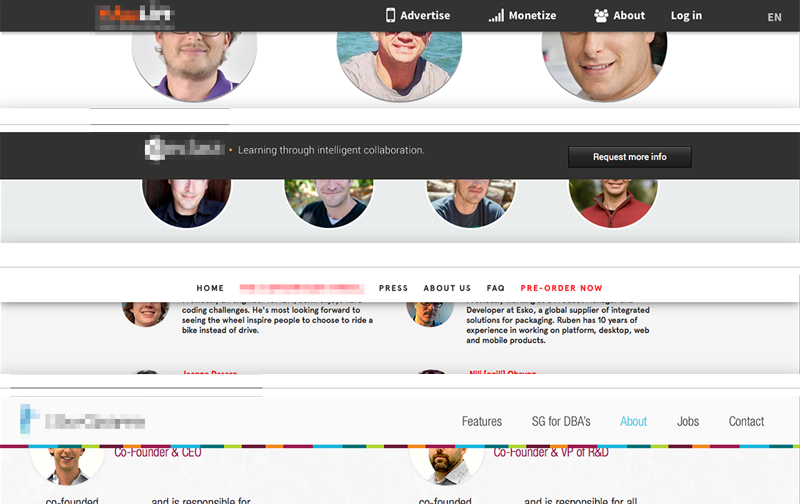
Above: Four startup sites I came across recently. Who is who? Which product is which? Wait, was that the site of that company I liked so much?
Conceptual and visual creativity used to be the integral ingredient of any brand introduction in the heyday of printed communications – they now are missing in action. To many of today’s entrepreneurs it is the product/service idea alone that counts, but sadly that idea gets lost without being embedded into a branded environment. The internet provides free tools; it does not mean that those fit into your company’s launch strategy. Leverage them when appropriate, avoid them when launching a brand. Consumers will get lost and your unique idea will look like a standard idea by using standard templates.
Be bold, be different, be conceptual. Go ahead and inject your enormous amount of creativity, strategy and moxie into your online presence, because it will be the place most people will meet your product/service first. And as far as I can tell it’s anything but standard.
CATEGORIES: Blog Your Brand Launch: Digital
A couple of weeks ago, Bob Garlick, host of Business Book Talk (poking through below), contacted me to schedule an interview about our book ‘How to Launch a Brand.’ With Bob sitting in Vancouver and myself in Los Angeles, I was immediately taken by surprise as there was no script that he shared with me, no canned answers to prep, no warmup chatter and no edits were made to our conversation.

The result is an honest and stimulating conversation between two individuals with a keen interest in design, branding and entrepreneurship, which I’d like to share with you. Below audio not only gives you a peek into our book, but also covers topics such as misconceptions of branding, brand strategy, how brands need to be different than 15 years ago and how to connect with your customers through branding:
Audio clip: Adobe Flash Player (version 9 or above) is required to play this audio clip. Download the latest version here. You also need to have JavaScript enabled in your browser.
(Can’t see above audio player in your E-Mail? Please listen to the audio via our site)
Now that I crossed the bridge by posting audio (how adventurous), I might as well share a quick video in which I further define ‘brand’ specifically for startups, filmed at a mentoring session (how advantageous) at the Founder Institute in San Diego two weeks ago.
CATEGORIES: Blog Startup Advice Your Brand Launch: Brand Atmosphere Your Brand Launch: Brand Strategy Your Brand Launch: Digital Your Brand Launch: Identity Your Brand Launch: Naming